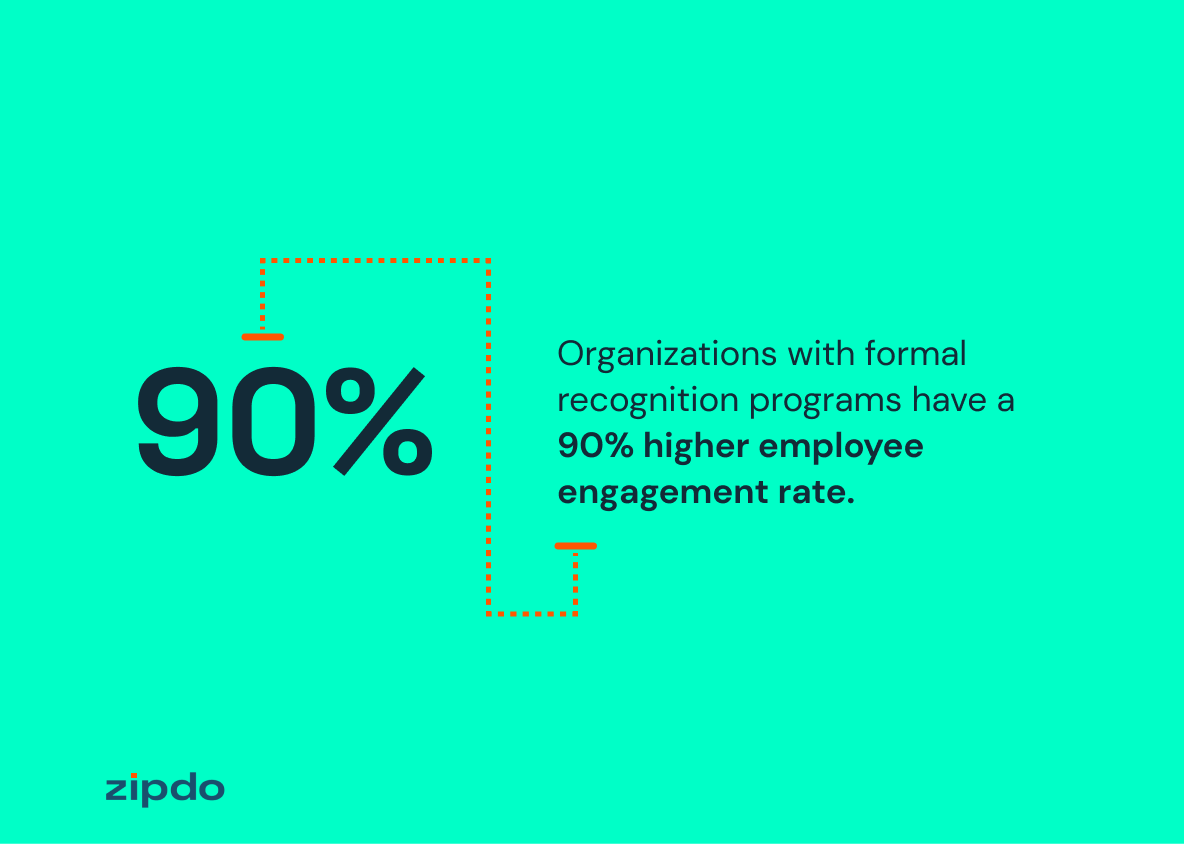In today’s fiercely competitive business landscape, employee recognition has emerged as a game-changing strategy for creating an exceptional workplace and driving unparalleled employee engagement. As experts in this field, we have personally witnessed the remarkable transformation that recognition programs can bring about – igniting morale, supercharging productivity, and fostering unwavering loyalty among employees.
However, recognition is not just about offering empty praise; it goes far beyond that. It is about wholeheartedly acknowledging and appreciating the relentless hard work, unwavering dedication, and invaluable contributions of your employees.
For an in-depth article about employee recognition, click here!
The impact of recognition on employee retention and satisfaction cannot be overstated. Employees who feel deeply appreciated are more likely to forge long-term bonds with their company. They develop an unbreakable sense of loyalty towards their organization because they know that every ounce of sweat they pour into their work will be acknowledged and rewarded.
By implementing highly effective recognition programs within your company’s DNA, you have the power to cultivate a culture where each team member feels cherished for their unique contributions. This paves the way for heightened job satisfaction levels, elevated motivation across the board, and seamless teamwork dynamics like never before seen – ultimately culminating in outstanding overall performance.
Exploring Dynamic Types of Employee Recognition Programs
When it comes to implementing employee recognition programs, there are various strategies and practices that can lead to a successful and rewarding experience for both employees and employers. We will provide you with valuable insights on how to create and improve these programs, ensuring they align with your company’s goals and values.
Peer-to-Peer Recognition
One highly effective strategy is peer-to-peer recognition. This program empowers employees to appreciate their colleagues’ efforts and achievements openly. By fostering a positive work culture where individuals feel valued by their peers, this approach encourages teamwork, collaboration, and camaraderie among team members.
- Builds strong relationships within teams
- Increases employee engagement and motivation
- Creates a supportive work environment
For example, at Company XYZ, they implemented a peer-to-peer recognition program called “Kudos Corner.” Employees have the opportunity to nominate their colleagues who demonstrate outstanding performance or go above and beyond their responsibilities. The recognized individuals receive public acknowledgment during team meetings.
Manager-to-Employee Recognition
Another effective approach is manager-to-employee recognition. In this program, managers play a crucial role in recognizing and rewarding their direct reports’ accomplishments based on firsthand knowledge of their contributions.
- Reinforces positive behavior within teams
- Strengthens the manager-subordinate relationship
- Provides opportunities for career development discussions
For instance, Company ABC has a monthly “Manager’s Choice” award where supervisors select one employee who demonstrated exceptional performance or made significant contributions to the company’s goals. The chosen employee receives a certificate along with additional perks like extra vacation days or gift cards.
Company-Wide Recognition
Lastly, consider implementing a company-wide recognition program that celebrates achievements impacting the entire organization rather than individual departments or teams. This approach recognizes milestones, exceptional projects, and outstanding performance aligned with your company’s values and goals.
- Promotes unity and shared purpose
- Reinforces organizational culture and values
- Encourages collaboration across departments
For example, Company DEF holds an annual awards ceremony called “The Excellence Awards,” where they recognize individuals or teams who have made significant contributions to the company’s success. The event includes speeches from top executives highlighting the impact of each recognized achievement.
Choosing the Right Program for Your Company
When selecting a recognition program for your workplace, it is essential to consider factors such as your company size, culture, and budget. Customizing the program to fit your organization’s specific needs will maximize its effectiveness. Additionally, involving employees in the decision-making process can increase their engagement and satisfaction with the chosen program.
Remember that employee recognition programs are most successful when they align with your overall business strategy and practices. By implementing a well-designed strategic recognition program tailored to your organization’s unique characteristics, you can create a positive work environment that fosters employee engagement, loyalty, and productivity.

Key Elements of Effective Recognition Programs
As experts in the field of employee recognition programs, we understand the importance of implementing strategies that truly make a difference. To ensure your program is effective and impactful, there are three key elements you should consider.
1. Timeliness
Prompt recognition is crucial when it comes to motivating and engaging employees. By acknowledging their achievements or exceptional performance in a timely manner, you show them that their efforts are valued and appreciated. Delayed recognition can diminish its impact and miss opportunities for boosting motivation.
2. Specificity
Personalized recognition tailored to individual accomplishments or contributions has a far greater impact than generic praise or rewards. When recognizing employees, be specific about what they did well and how it positively influenced the company or team. This level of detail adds depth and meaning to the recognition, making it more memorable and motivating.
3. Relevance
For your recognition program to be successful, it must align with your company’s values, goals, and culture. By directly tying recognition to these core aspects of your organization, you reinforce desired behaviors while fostering a sense of purpose among employees. It creates a positive work environment where everyone understands how their efforts contribute towards shared objectives.
In addition to these essential components, inclusivity and fairness play vital roles in successful employee recognition programs:
- Inclusivity: A truly effective program ensures that all employees feel included regardless of their role or level within the organization. Recognizing individuals from different departments promotes collaboration while fostering unity across various areas.
- Fairness: Implementing any type of reward system requires fairness; otherwise, it can lead to demotivation if perceived as biased or favoring certain individuals unfairly over others.
By incorporating these key elements – timeliness, specificity, relevance, inclusivity, and fairness – into your employee recognition program guide, you will create a culture where appreciation thrives and encourages employees to perform at their best. Remember that one-size-fits-all strategies are not effective; tailor your program to fit the unique needs and values of your workplace.
Steps to Implementing an Employee Recognition Program
Welcome to our expert guide on implementing employee recognition programs. As seasoned professionals in the field, we understand the importance of recognizing and appreciating your employees’ efforts. By following these strategies, you can create a positive work environment that boosts morale, productivity, and loyalty.
1. Plan Strategically
The first step is to carefully plan your employee recognition program. Define clear objectives based on what you hope to achieve – whether it’s increasing satisfaction, improving retention rates, or enhancing overall performance.
2. Design With Purpose
Once you have established your goals, it’s time to design the structure of your program. Consider different types of rewards and incentives that align with your company culture and values. Decide how these rewards will be distributed – whether through peer-to-peer recognition programs, manager-to-employee initiatives, or company-wide endeavors.
3. Involve Management and HR Experts
Involving management and human resources (HR) throughout the implementation process is crucial for success. They bring valuable insights into ensuring alignment with company values while providing support for execution.
4. Communicate Effectively
Effective communication plays a vital role in introducing a new employee recognition program successfully. Clearly articulate the purpose of the program along with its benefits for both employees and the organization as a whole. Provide specific guidelines or criteria for receiving recognition to avoid any confusion.
5. Measure Impact
To ensure the utmost effectiveness of your program from day one, it is crucial to establish metrics for measurement. By tracking changes in productivity levels or conducting regular surveys on employee satisfaction, you can gauge the impact and success of your strategies. Not only does this allow you to identify areas for improvement, but it also provides valuable insights into the overall engagement and happiness of your employees.
6. Adapt & Improve Continuously
Just like any other strategic initiative within an organization, continuous evaluation is key to success. Gather feedback from employees and analyze data collected over time to adapt and improve your approach accordingly.
By diligently following these steps during implementation, you can create an exceptional employee recognition program tailored specifically to meet your company’s needs and culture. Remember, the best programs are those that align with company values, provide timely and specific recognition, and foster inclusivity and fairness.

Successful Employee Recognition Programs: Real-Life Examples
Welcome to our in-depth exploration of successful employee recognition programs. In this section, we will delve into real-life case studies that showcase the strategies and results achieved by companies that have implemented effective recognition programs. By examining these examples, you’ll gain valuable insights into how to create a program that truly engages and motivates your workforce.
Case Study 1
As a global tech company renowned for innovation and employee satisfaction, this corporation implemented a peer-to-peer recognition program with outstanding success. Through this program, employees had the opportunity to nominate their colleagues for exceptional contributions. The result? A significant boost in morale and a strengthened sense of camaraderie among team members. Not only did productivity soar, but collaboration within teams reached new heights.
Case Study 2
Seeking to improve retention rates and overall job satisfaction, a company introduced manager-to-employee recognition programs with remarkable outcomes. Supervisors regularly acknowledged exceptional performance through personalized notes or small rewards—a simple yet powerful gesture that made employees feel valued and motivated to excel further.
Case Study 3
With inclusivity as a top priority in their workplace culture, yet another company established clear criteria for eligibility in their recognition program while actively involving all employees in the process. They even sought feedback from their workforce on preferred types of rewards—resulting in heightened engagement and motivation across the organization.
These case studies underscore the importance of tailoring your recognition program to align with your organizational goals and values, as well as considering the unique needs and preferences of your employees.
Key Lessons Learned:
- Clear communication is paramount: Ensure all employees understand the purpose, guidelines, and benefits of your recognition program.
- Customize based on context: Tailor your approach according to factors such as company culture, size, and budgetary constraints.
- Inclusivity breeds fairness: Provide equal opportunities for every employee to be recognized.
- Timeliness maximizes impact: Recognize achievements promptly to enhance their significance.
- Embrace variety in rewards: Offer a diverse range of options, including monetary incentives and non-monetary rewards like extra time off or professional development opportunities.
By studying these case studies, you’ll find inspiration and gain expert insights to create a recognition program that aligns seamlessly with your company’s goals and values. Remember, the key to success lies in understanding your employees’ needs and fostering a culture of appreciation within your organization. Let us guide you on this journey toward creating an exceptional employee recognition program that will elevate your workplace engagement and satisfaction levels.
Choosing the Right Recognition Program for Your Company
Implementing an employee recognition program is a strategic decision that can have a profound impact on your workplace. To ensure its success, it’s crucial to choose the right program that aligns with your company’s unique needs and values. By doing so, you can create an environment where employees feel appreciated and motivated to excel.
Here are some expert tips to consider when selecting a recognition program:
- Tailor it to your company size: The size of your organization plays a significant role in determining the most effective type of recognition program. Larger companies may benefit from formal programs with structured processes, while smaller businesses thrive on more informal approaches that foster close-knit relationships among employees.
- Embrace your culture: Every workplace has its own distinct culture and values. It’s essential to choose a recognition program that resonates with these core principles. For example, if teamwork is highly valued in your organization, implementing peer-to-peer recognition programs can be incredibly impactful as employees acknowledge each other’s contributions.
- Stick to a reasonable budget: Recognizing employee efforts should always be a priority; however, budget constraints need consideration too. Luckily, there are numerous cost-effective options available today that offer meaningful rewards and appreciation without straining finances.
- Get employees involved: Involving employees in the decision-making process enhances their engagement with the chosen recognition program significantly. Seek input from different departments or conduct surveys to gain insights into their preferences and desires.
- Align strategically: A successful recognition strategy goes beyond being just another HR initiative—it should align seamlessly with broader organizational goals and objectives.
By carefully considering these factors, you can select a recognition program that not only meets your company’s needs but also resonates with your employees. Remember, the ultimate goal is to create an environment where employees feel valued and appreciated for their contributions.
In conclusion, implementing an employee recognition program requires thoughtful consideration of various factors such as company size, culture, budgeting, customization options, employee involvement, and strategic alignment. By choosing the perfect program tailored to your organization’s specific needs and values, you can cultivate a positive work environment that fosters engagement, loyalty, and productivity. Take the first step towards recognizing your employees’ efforts and contributions today!


